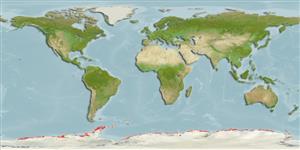Actinopterygii (ray-finned fishes) >
Perciformes (Perch-likes) >
Nototheniidae (Cod icefishes)
Etymology: Notothenia: Greek, 'notos', ou; ?????, ??), from the south + Greek, 'e 'eutheneia',as or 'euthenia', as (????????, ??; ???????, ??), abundance (P. Romero, pers.comm. 01/16); neglecta: Named after Dr. Nybelin's feeling that this divergent form of coriiceps has been overlooked (Ref. 11892).
Environment / Climate / Range
Ecology
Marine; benthopelagic; depth range 1 - 95 m (Ref. 11892), usually 1 - 90 m (Ref. 11892). Polar, preferred ?
Southern Ocean: coast of the Antarctic continent, Antarctic Peninsula, South Georgia, South Shetland, South Orkney Islands and Peter I Island.
Size / Weight / Age
Maturity: Lm ? range ? - ? cm
Max length : 45.0 cm SL male/unsexed; (Ref. 11892)
Short description
Morphology | Morphometrics
Dorsal
spines
(total): 3 - 7;
Dorsal
soft rays
(total): 37-40;
Anal
spines: 0;
Anal
soft rays: 27 - 32. Caudal fin subtruncate or slightly rounded, emarginate in young. Coloration more spectacular compared to other nototheniids. Juveniles with a black blotch on distal end of pectoral fin.
Juveniles found in 1-10 m depth and possibly having a pelagic habit, adults in deeper water (Ref. 11892). Adults feed on crustaceans and fishes (Ref. 11892). Spawn once a year (Ref. 57661). Some information needs to be transferred from N. coriiceps to this species (RF).
Mature females may spawn for the first time from around 6-8 years of age (Ref. 71843).
Miller, R.G., 1993. A history and atlas of the fishes of the Antarctic Ocean. Foresta Institute, Nevada. 792 p. (Ref. 11892)
IUCN Red List Status (Ref. 115185)
CITES (Ref. 94142)
Not Evaluated
Threat to humans
Harmless
Human uses
Fisheries: subsistence fisheries
More information
ReferencesAquacultureAquaculture profileStrainsGeneticsAllele frequenciesHeritabilityDiseasesProcessingMass conversion
Tools
Special reports
Download XML
Internet sources
Estimates of some properties based on models
Phylogenetic diversity index (Ref.
82805): PD
50 = 0.5078 [Uniqueness, from 0.5 = low to 2.0 = high].
Bayesian length-weight: a=0.00631 (0.00294 - 0.01353), b=3.19 (3.01 - 3.37), in cm Total Length, based on LWR estimates for this (Sub)family-body shape (Ref.
93245).
Trophic Level (Ref.
69278): 3.3 ±0.2 se; Based on diet studies.
Resilience (Ref.
69278): Low, minimum population doubling time 4.5 - 14 years (tm=7-8; Fec > 10,000).
Vulnerability (Ref.
59153): High to very high vulnerability (69 of 100) .
